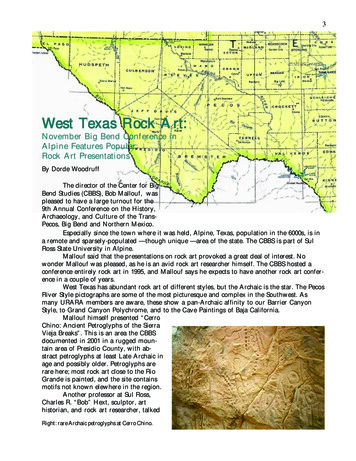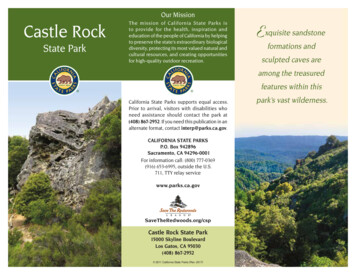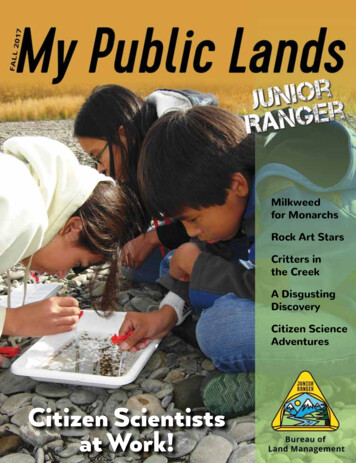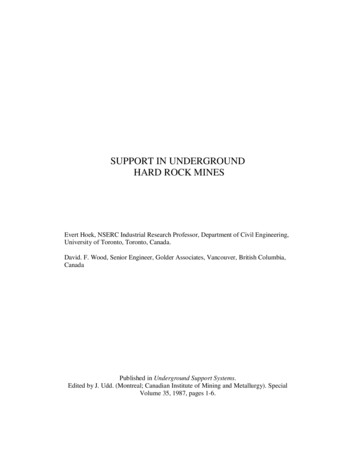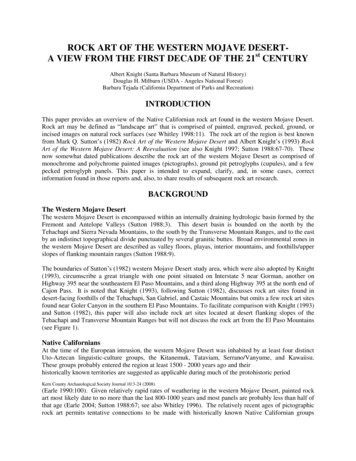
Transcription
ROCK ART OF THE WESTERN MOJAVE DESERTA VIEW FROM THE FIRST DECADE OF THE 21st CENTURYAlbert Knight (Santa Barbara Museum of Natural History)Douglas H. Milburn (USDA - Angeles National Forest)Barbara Tejada (California Department of Parks and Recreation)INTRODUCTIONThis paper provides an overview of the Native Californian rock art found in the western Mojave Desert.Rock art may be defined as “landscape art” that is comprised of painted, engraved, pecked, ground, orincised images on natural rock surfaces (see Whitley 1998:11). The rock art of the region is best knownfrom Mark Q. Sutton’s (1982) Rock Art of the Western Mojave Desert and Albert Knight’s (1993) RockArt of the Western Mojave Desert: A Reevaluation (see also Knight 1997; Sutton 1988:67-70). Thesenow somewhat dated publications describe the rock art of the western Mojave Desert as comprised ofmonochrome and polychrome painted images (pictographs), ground pit petroglyphs (cupules), and a fewpecked petroglyph panels. This paper is intended to expand, clarify, and, in some cases, correctinformation found in those reports and, also, to share results of subsequent rock art research.BACKGROUNDThe Western Mojave DesertThe western Mojave Desert is encompassed within an internally draining hydrologic basin formed by theFremont and Antelope Valleys (Sutton 1988:3). This desert basin is bounded on the north by theTehachapi and Sierra Nevada Mountains, to the south by the Transverse Mountain Ranges, and to the eastby an indistinct topographical divide punctuated by several granitic buttes. Broad environmental zones inthe western Mojave Desert are described as valley floors, playas, interior mountains, and foothills/upperslopes of flanking mountain ranges (Sutton 1988:9).The boundaries of Sutton’s (1982) western Mojave Desert study area, which were also adopted by Knight(1993), circumscribe a great triangle with one point situated on Interstate 5 near Gorman, another onHighway 395 near the southeastern El Paso Mountains, and a third along Highway 395 at the north end ofCajon Pass. It is noted that Knight (1993), following Sutton (1982), discusses rock art sites found indesert-facing foothills of the Tehachapi, San Gabriel, and Castaic Mountains but omits a few rock art sitesfound near Goler Canyon in the southern El Paso Mountains. To facilitate comparison with Knight (1993)and Sutton (1982), this paper will also include rock art sites located at desert flanking slopes of theTehachapi and Transverse Mountain Ranges but will not discuss the rock art from the El Paso Mountains(see Figure 1).Native CaliforniansAt the time of the European intrusion, the western Mojave Desert was inhabited by at least four distinctUto-Aztecan linguistic-culture groups, the Kitanemuk, Tataviam, Serrano/Vanyume, and Kawaiisu.These groups probably entered the region at least 1500 - 2000 years ago and theirhistorically known territories are suggested as applicable during much of the protohistoric periodKern County Archaeological Society Journal 10:3-24 (2008)(Earle 1990:100). Given relatively rapid rates of weathering in the western Mojave Desert, painted rockart most likely date to no more than the last 800-1000 years and most panels are probably less than half ofthat age (Earle 2004; Sutton 1988:67; see also Whitley 1996). The relatively recent ages of pictographicrock art permits tentative connections to be made with historically known Native Californian groups
(Earle 2004). By contrast, the antiquity of petroglyphic rock art, which is more resistant to weathering,remains highly uncertain and any connections with later period Uto-Aztecan culture groups areproblematic.Figure 1. Rock art locations in the western Mojave Desert: (A) KER-273 and -1193; (B) KER-137; (C)KER-302; (D) LAN-192, -1731, -2368 and Hamil Ranch; (E) LAN-484; (F) LAN-721; (G) LAN-298;(H) LAN-947; (I) LAN-305; (J) LAN-447/723; (K) LAN-1767, -1768, and -3343; (L) LAN-1977; (M)LAN-2200; and (N) FS Nos. 05-01-54-236 and -237.The Kitanemuk (also referred to as Kitanemuk Serranos) held territory in Tehachapi Mountains and thewestern Antelope Valley (Sutton 1988:19). The Kitanemuk spoke a Serran dialect of Takic that wasrelated the dialects spoken by Serrano-Vanyume groups in the eastern Antelope Valley and, moredistantly, to the language of Tataviam groups in the upper Santa Clara River watershed (Earle 1990; Earleet al. 1995; Johnson and Earle 1990:197). The Kitanemuk were greatly influenced by neighboringInterior Chumash and Yokuts groups and practiced a culture that contained many non-Serrano elements(Earle 2004), probably including painted rock art traditions.The Tataviam (a Kitanemuk-derived name), also referred to as the Alliklik by the Ventureño Chumash,are a little known Takic language/culture group who occupied the entire upper Santa Clara River drainagefrom Piru on the west, San Fernando Pass on the south, and Soledad Pass on the east (Johnson and Earle1990:199). Tataviam territory appears to have extended northward to encompass the middle segments ofPiru Creek, Sierra Pelona Mountains, and southwestern fringe of the Antelope Valley (Earle 1990:94;Johnson and Earle 1990:192-197). Tataviam culture appears to have been influenced by neighboringChumash groups and pictographs found within their postulated territory contain a few motifs that arestylistically similar to Chumash painted rock art (see Whitley 1996, 2003). Pitted cupule boulders arealso seemingly ubiquitous throughout much of Tataviam territory; however, ages and cultural associationsof this particular rock art tradition remains unclear.
Closely related clans of the Serrano and Vanyume (Beñeme), the latter sometimes referred to as DesertSerranos, inhabited the southeastern Antelope Valley, Cajon Pass, upper Mojave River drainages, and SanBernardino Mountains (Earle 1990; Earle et al. 1995). The Serrano-Vanyume also controlled territory indesert foothills of the eastern San Gabriel Mountains, including Sheep, Deadman (Graveyard), Big Rock,and Littlerock Canyons (Earle 1990; Earle, et al. 1995; Kroeber 1925:602, 616). A localized Serranspeaking clan group known as the Mamaviatam is thought to have inhabited the Little Rock Creek area eastof Soledad Pass while the another clan, the Amútskajam, controlled territory in the eastern San GabrielMountains and Cajon Pass corridor (Earle 1990; Earle et al. 1995:2.8-11). Serrano—Vanyume painted rockart traditions were shared with most other Takic groups in southwestern California (Whitley e.g., 1996,2000).The Numic-speaking Kawaiisu (or Nuooah) occupied the southern Sierra Nevada Mountains, northernTehachapi Mountains, northerly portions of the Antelope Valley, southern half of the Panamint Valley,Death Valley, and the Searles Lake area (Underwood 2006; Zigmond 1986). Kroeber (1925:602, 616)reported that some Kawaiisu informants claimed to have been born at Sheep Creek and Deadman Creeksin the San Gabriel Mountains and speculated that much of the western Mojave Desert might have beenwithin Kawaiisu territory. Kawaiisu painted rock art in the Sierras and Tehachapi's are stylisticallyrelated to rock art traditions of the Yokuts and Chumash.By the early 1800s, after removal of most Takic populations into the Spanish mission system, Numicspeaking Southern Piaute/Chemehuevi groups from interior desert areas began to move southward alongthe Mojave River and into the Antelope Valley. By the 1840s, Numic raiders had forced theabandonment of remnant Takic settlements at Cajon Pass and other desert corridors that led towardscoastal California (Earle et al.1995:2.33-34). Historic period Numic populations may also have left rockart markings in the western Mojave Desert; however, these remain so far undefined.THE ROCK ARTRock Art ClassificationsPainted Rock Art. Pictographic rock art in the western Mojave Desert is recorded (sometimesincorrectly) at CA-KER-129, -130, 137, -273, and -1193; CA-LAN-192, -305, -447/723, -484, -721, -947,-1731, -1789/H, -2200, and -2368. Sutton (1982:35, 1988:67, 70) suggests that all monochromatic(mostly red) paintings in the western Mojave Desert are indicative of the Southern California RectilinearStyle (see Hedges 1973) while all polychrome painted images, which are primarily located in theTehachapi foothills, relate to the Southern Sierra Curvilinear Painted Style (see Heizer and Clewlow1973). In 1993, Knight proposed an extension of the Southern Sierra Painted Style to a rocky butte areaof northeastern Los Angeles County and also suggested that the Southern California Rectilinear Style didnot reach north of the San Andreas Fault Zone (these are both views Knight no longer holds).The Southern California Rectilinear Abstract Painted Style is described as predominantly comprised ofrectilinear designs, including chevrons, zigzags, straight lines, diamond chains, crosshatching, diamond“nets,” crosses, as well as circle/dot designs and occasional handprints (Hedges 1973). The SouthernCalifornia Rectilinear Style is characteristic of some, but not all, Takic groups in southwestern Californiaand is also found, in diminished form, among the Yuman-speaking Tipai-Ipai and Kumeyaay (Whitley2000). Geographically, the Southern California Rectilinear Style stretches from the southeasternAntelope Valley southward through portions of San Bernardino, Riverside, Los Angeles, Orange, and SanDiego Counties; however, it is noted that Knight (1993:55-57) disagrees with Hedges’ (1973)incorporation of the style into western and southern portions of Los Angeles County. The SouthernCalifornia Rectilinear Style is typically found on large open boulders at or near later period villages andthere is considerable ethnographic evidence to indicate that this rock art tradition was associated with
boys’ and girls’ puberty initiation ceremonies (see Clewlow 1978:624; Earle 2004; Hedges 1973; cf.Whitley 1996:9-10, 2003).By contrast, the Southern Sierra Curvilinear Painted Style found at northern margins of the westernMojave Desert is characterized by large complex polychrome paintings and smaller monochromatic(mostly red) panels dominated by circular and linear motifs and stylized anthropomorphic andzoomorphic forms. This rock art style is concentrated in the foothills of Kern, Fresno, and TulareCounties and is generally thought to be connected to shamanistic practices of the Penution-speakingYokuts and a number of neighboring Uto-Aztecan groups, including the Kawaiisu, Kitanemuk, andTubatulabal (Clewlow 1978:625; Earle 2004; Heizer and Clewlow 1973; Whitley 1992). It has been longbeen recognized that the Southern Sierra Painted Style is stylistically quite similar to the painted rock artof Chumashan groups at coastal and interior areas (see, as examples, Clewlow 1978; Grant 1965:110-11,1971; Whitley e.g., 1992, 1996, 1997, 2000, 2003). Many researchers now accept the notion that the rockart paintings of the Chumash, Yokuts, and a series of smaller groups in between, including probably theTataviam, comprise variants of a stylistically-connected tradition that stretches from the Santa BarbaraChannel to the southern Sierra Nevada Mountains (see Grant 1971; Whitley 1992, 1996, 2003, andelsewhere). While this painted rock art tradition includes some of the most spectacular polychromepictograph panels found in North America, it is important to recognize that the majority of the paintedpanels are quite small and comprised of simple monochromatic motifs (see Whitley 1996, 2003).Pitted Rock Petroglyphs (Cupules). Cupule rock art found in the western Mojave Desert is connected tothe Far Western Pit and Groove Tradition that is widespread throughout California, the Great Basin, andthe Columbia Plateau (see True and Baumhoff 1981:226; Whitley e.g., 1996:10-11). Cupules are circulardepressions that are carved, pecked, or ground into horizontal, vertical, or angled rock surfaces to create apattern of pits. Cupules found in southern California are relatively shallow in relation to diameters, varyin size from a few centimeters to over 15 cm, range in number on any given boulder from few to dozens,and are sometimes associated with linear groves and, more rarely, petroglyph images (Earle 2004; cf.Payen 1968). Cupules may sometimes be confused with incipient or small-sized mortar holes, but canoften be distinguished by locations on vertical or inclined surfaces, occurrence in multiple patterns, orassociation with distinct archaeological contexts (Earle 2004). As with other kinds of petroglyphs, it isgenerally difficult to ascertain ages of cupules because of significant resistance to weathering.Sutton (1988:67) describes cupule boulders in the western Mojave Desert as “fairly common;” however,the majority of these sites are actually situated along southern foothill areas. Knight (1993, 1997) reportsseveral cupule rock art concentrations that are found in association with other kinds of rock art. Pittedcupule (or cupule-like) images are specifically recorded at CA-KER-273 and 302, CA-LAN-447/723,947, 1767, 1768, 1789/H, 1977, 2368, 3343, and 3486, and FS No. 05-01-54-236 and 237. Anothercupule boulder, referred to as CT-10, is also known for the westernmost Antelope Valley; however,information regarding this rock art site is not readily available.With varying degrees of plausibility, a number of different origins and uses of cupule rock art have beenreported for California, including foot trail markers, astronomical observations, weather control magic,indicators of territorial boundaries, and female fertility ceremonies (Earle 2004). In far northwesternCalifornia, pit-and-groove petroglyphs are associated with weather magic rituals of shamans while furthersouth, in Pomo territory, cupules appear to be associated with female fertility rituals (see Payen 1968;Whitley 1996:10-11; 1997, 2000). In the west-central Sierra Nevada Mountains, cupules are sometimesfound directly associated with vulva-form petroglyphs and these were made almost certainly to enhancefemale fertility (Payen 1968).From the Yokuts region southwards, cupule rock art is generally reported as having been produced in an“abstract generalized girls’ puberty ceremony undertaken at first menses and signaling the arrival of
womanhood” (Whitley 1996:11). However, True and Baumhoff (1981) state that there is no ethnographicevidence from southern California to suggest that cupules are associated with coming-of-age initiationceremonies, or with any other rituals for that matter. Due to scant ethnographic data, it should not beassumed that cupules found in southern California represent the products of historically known culturegroups (Earle 2004:24-27).Pecked Petroglyphs. Pecked petroglyph patterns appear to be quite scarce in the western Mojave Desert.Petroglyphs found at CA-KER-302 and the Hamil Ranch (no trinomial) are representative of the GreatBasin Abstract Pecked Style. This style of rock art, which includes curvilinear and rectilinearsubcategories, is comprised of spirals, concentric circles, meandering lines, rayed circles and similarimages, with occasional zoomorphic or anthropomorphic figures (Heizer and Baumhoff 1962; see Grant1971:232,237; Clewlow 1978:620-621). In contrast to previous reports, the faintly visible petroglyphsreported at LAN-947 have not yet been definitely related to the Great Basin Pecked Style or any otherstyle (Beth Padon, personal communication 2008; cf. Knight 1993:46).Perhaps relevant to western Mojave Desert rock art, some petroglyph images found at the SoledadCanyon corridor may have been manufactured coeval with spatially associated cupules. These rock artsites suggest that distinctions between cupules and petroglyphs in southern California may not be as greatas once thought. As example, cupule rock art at CA-LAN-540 near southern foothills of the Sierra PelonaRidge, which reportedly contains the largest concentration of cupule pits in south-central California,encompasses a few pecked petroglyphs, including a hollow circle; a zigzag; a “rake” terminating incupules, an inverted “U” with a central bisecting line, and a set of parallel lines (Whitley 1996:30-31;2003). Similarly, elaborate pecked curvilinear petroglyphs are directly associated with a significantnumber of cupules in the Shannon Valley near Acton/Escondido Canyon (Robinson 1987). Whitley(1996:10; 2003) associates these petroglyph patterns to the California Engraved Variant of the CaliforniaTradition, which includes pecked, incised, or scratched simple geometric petroglyph forms. TheCalifornia Engraved Variant is most common in northern California but also occurs in small quantities toat least the Mexican border (Whitley 1996:10).The Rock Art SitesSubsequent to Knight’s (1993) report, a number of additional rock art sites have been discovered in thewestern Mojave Desert and, conversely, some previously reported sites have been determined as nonexistent or incorrectly described. This section provides updated descriptions of most known rock art sitesfound in the western Mojave Desert (see Table 1).CA-KER-129 (Willow Springs Village Site). KER-129 was once the location of the largest native (i.e.Kitanemuk) community in the northwest Mojave Desert and is also considered an important place to earlylocal history. Sutton (1982, 1988:67) states that there are elaborate polychrome pictographs present atKER-129; however, Knight (1993:41) reports that there is no rock art at Willow Springs, perhaps due to alack of suitable rocks. Knight (1993:41) concludes that the rock art described for Willow Springs isactually found several miles away in Burnham Canyon at KER-273 and -1193.CA-KER-130. KER-130 is described as containing pictographs in a rock shelter; however, no rockshelter exists at the recorded location and, in fact, there are no rock outcrops at all at the recorded locationof this site (note that a lithic scatter IS present). Haensel (1964) refers to the site as “Desert Butte;”however, Desert Butte is actually located several miles to the west. Knight (1993:42) concludes thatKER-130 represents a mis-mapped site (at least in terms of the “rock art” component) and the recordedrock art is actually located at KER-137.CA-KER-137 (Desert Butte). KER-137 contains the shallow rock shelter originally described for KER-
130. Monochromatic black pictographs were apparently once visible in the rock shelter; however, thepaintings appear to be almost (or perhaps completely) weathered away (Knight 1993:43). The specificstyle of the black pigment pictographs remains uncertain. Unlike many rock art sites in the westernMojave Desert, KER-137 is considered quite accessible to visitors (Knight 1993:43).CA-KER-273 and -KER-1193 (Burham Canyon Sites). The highly important pictograph panels KER273 and KER-1193 are situated on granite bedrock outcrops in Burham Canyon a few miles northwest ofWillow Springs. These pictograph loci are described as representing the “real” Willow Springs rock art(Knight 1993:43-44).The still-impressive polychrome pictograph panel at KER-273, which is located in a rock shelter thatoverlooks KER-1193, is reported to be “one of the most elaborate and well-preserved pictograph panels insouthern California” (Knight 1993:44). The main panel is comprised of a large fantastic polychromeabstract image in red, white, black, orange, and a small amount of blue. Smaller associated pictographsinclude a red so-called “teddy bear” motif (similar to those found in northeastern Tehachapi Valley atCA-KER-508). The polychromatic paintings at KER- 273 are assigned to the Southern Sierra Style andare most likely associated with Kitanemuk habitation (cf. Knight 1993:44). Mortar-like depressions andcupule rock art are also reported at this site (Knight 1993:44; Sutton 1988:67). A less complex panel atnearby KER-1193 is comprised of a red sun-like symbol and about 30 short dashes (see Sutton 1982:30,Fig. 2). Speculatively, this panel may be associated with a possible winter solstice observation station(Knight 1993).In 1990, Andy Greene, a Kawaiisu elder, reported that KER-273 was used as a “birthing cave” byKitanemuk, Kawaiisu, and Tataviam women (Knight 1993:43-44). This significant ethnographicinformation may or may not be associated with the original origins and functions of the rock art. CharlieCooke, a Chumash chief, has stated that the Burnham Canyon rock art sites, which are situated on publiclands administered by the Bureau of Land Management, are sacred to local Native American people andshould not be casually visited (Knight 1993:44, 57).CA-KER-302 (Sweetser Site). KER-302, which is located in the Rosamond Hills, comprises the type-sitefor Glennan’s hypothesized Pinto-age “Rhyolite Tradition” in the western Mojave Desert. KER-302contains petroglyphs that are clearly classifiable within the Great Basin Pecked Abstract Style (Knight1993). Glennan (1971:6) initially described the petroglyph rock art as “ a large, roughly sphericalboulder which is covered on two sides with pecked geometric design elements .the surface of theboulder is quite weathered .it is quite difficult to determine the design elements originally present.” Inaddition to the primary petroglyph panel, three small adjacent boulders also each exhibit one or twosimple petroglyph images. Knight’s (1993:44) statement about the absence of cupules at this site isrevised in this paper due subsequent discovery of four or five cupule pits adjacent to one of the petroglyphpatterns.Table 1. Rock Art Sites in the Western Mojave 7CA-KER-273PictographsPetroglyphsCupules00Black pigment(weatheredaway)Polychrome andMonochrome0000000Cupules : no rock artMis-mapped: no rock artClassification not currentlypossibleSSP / Probable Kawaiisu origins.Spatially associated with CAKER-1193
tedlyvisible in 1920s–no -447/723CA-LAN-484CA-LAN-721RedMonochromeRed and blackMonochromePolychrome andMonochrome4 Petroglyphboulders0000Present(number notreported)0RedMonochrome1 PetroglyphboulderCA-LAN-1731Polychrome andMonochromeCA-LAN-1767,1768, 33430Vulva-likeforms reportedin vicinity0Red and black(at LAN-298)Monochrome0Nearbycupulesrecorded asCA-LAN348607-8 ses CALAN-298CA-LAN-1977uncertain).6-7 cupulesare present0-0CA-LAN-209601 1 vulva-likeformCA-LAN-3486Red, black,whiteMonochrome005-01-54-023601 peckedserpentine motif05-01-54-023700Hamil Ranch01CT-10 (westernAntelope Valley)000GBP; FWPGSSP / Probable Kawaiisu origins.Spatially associated with CAKER-273Pictograph classification notpossible/Should not now beconsidered as a pictograph siteThe reported petroglyphs do notappear to exist.SCRA - associated withMamaviatam Serrano clanIn mountains south of the desertPrimarily SSP (probably associatedwith Kitanemuk and/or Tataviamgroups)SCRA -very weathered;Possible GBPAssociated with Kawaiisu affiliated groupsMany cupulepits at eachsiteMany cupulesat several lociFWPGCupules on atleast fiveboulders0Associated with a habitation site indesert foothills07-8 smallcrude cupulepits.Many cupules26 cupule pitson singleboulder20 cupuleson a singleboulder0Cupule panelin cleft ofboulderPictographs possibly representSCRA; FWPGForm is similar to other features atPiute Buttes and at CA-LAN-2368SCRA associated with SerranohabitationSCRA pictographs associated withSerrano habitationFWPG /probable SerranoterritoryFWPG/ in Serrano territoryFWPG / in Serrano territoryGBP curvilinearFWPGSSP Southern Sierra Painted Style; SCRA Southern California Rectilinear Abstract Style;GBP Great Basin Pecked Style GBP; FWPG Far Western Pit and Groove Style.
KER-302 is situated on private property and the occupants of an adjacent house are currently not happywith intrusive rock art “students” who keep invading their property, almost always quiteuninvited. An elderly male occupant of the property, in fact, suggested to a writer of this paper (Knight)that his future research should be conducted in a very hot place – and he did not mean another place in theMojave Desert! Rock art researchers are well advised to not trespass on the private property at KER-302.CA-LAN-192 (Lovejoy Springs). According to the results of a recent archaeological study, this majordesert spring site has supported human habitation for at least three thousand years (Price et al. 2004).Pictograph panels were reported in the 1920s; however, these apparently are no longer in existence (Earle2004). Multiple cupule loci have recently been recorded in the general vicinity (see LAN-3486 below).CA-LAN-298. LAN-298 is a habitation site at Fairmont Buttes that contains a red pigment pictograph.LAN-298 is now consolidated within the larger Fairmont/Antelope Buttes village complex (see CA-LAN1789/H below).CA-LAN-305. Based on available information, Knight (1993:46-47) reported the presence of petroglyphimages and included an illustration of Becker’s (1990) sketch. However, in March 2004, Knightconducted a field check and, even with a site record form in hand, was unable to relocate any petroglyphs.At this time, LAN-305 is not considered by the writers to represent a rock art site.CA-LAN-447/723 (Big Rock Creek). This monochromatic pictograph site, which has been assigned twotrinomials, is found on private property situated along Big Rock Creek in the San Gabriel Mountainfoothills of the eastern Antelope Valley. The site consists of a single panel of pictographs located on anopen exposure of a large east-facing sandstone bedrock outcrop, about four meters above the stream bed.The red pictograph elements, which generally correspond to the Southern California Rectilinear AbstractStyle, are illustrated in Knight (1993:48, Figure 4) and Sutton (1988:69, Figure 26b); however, in theinterest of accuracy, it is noted that Knight omits a “lizard” motif in his illustration and Sutton’s sketch isdepicted upside down. The site also contains several small shallow grinding depressions (cupule-like andmortar-like) that may be ritualistic rather than functional in origin.In 1996, one of the writers of this report (Milburn) and Dr. David S. Whitley led a crew of Forest ServicePassport-in-Time (PIT) volunteers to document the pictographs at LAN-447/723. This project resulted inthe following description:The single panel at the site is painted in red, and portrays ten motifs;however, two different colors are identifiable. The majority (horizontal rake,upper diamond chain, 4 circles and a zigzag) are all Dusky Red (Munsell10R3/4); the remainder (vertical rake, lower diamond chain and “lizard”) areDark Red (Munsell 10R3/6). Most likely, these two colors reflect twoepisodes of painting at this site as the color distinction is very subtle, itselfreflecting what is most likely two elements of pigment rather than any effort atpolychromatic painting.With the exception of the lizard, the motifs are all “geometric.” The zigzagand diamond chains, however, are entopic designs which may be interpretedas rattlesnake motifs, inasmuch as these motifs were universally identifiedethnographically .Its age is unknown although it seems unlikely that thepaintings would be preserved on this open, southeast-facing panel, for anygreat length of time. Based on preservation factors alone, it seems unlikelythat it could be more than 1000 years old, and an age of less than half that
time is probably most likely, especially given the relative lack of fadingevident in most of these motifs [Whitley 1996:17-18].Figure 2. Pictograph at LAN-447/723.LAN-447/723 is reported to be located within the territory of the Mamaviatam clan, a sub-group of theSerrano-Vanyume (Earle 1990; Earle et al. 1995). Due to the brightness of the rock art pigment, the site isassessed as “relatively recent in age, probably on the order of only a few hundred years” (Whitley1996:29). The possibility that rock art relates to girls’ puberty ceremonies is conceded; however, thepresence of the lizard-like motif, among other lines of reasoning, suggests the “ work of one or moreshamans, responsible for two separate incidents of rock painting .A significant number of rattlesnakemotifs at this site suggest that it was a vision quest location of one or more rattlesnake shamans” (Whitley(1996:16-17).During a 2007 site visit, one of the authors (Tejada) observed that a water pipeline had recently beeninstalled immediately adjacent to the bedrock outcrop containing the rock art panel. While the pipelinedoes not appear to have damaged the rock art, it has affected other aspects of the site’s overall integrity.CA-LAN-484 (Burnt Peak Pictograph Site). This site is situated on private property in the mountainssomewhat south of the western end of the desert but is included in this paper because it has beenpreviously discussed by Sutton (1982) and Knight (1993). This site consists of two red pigmentpictographs, one or both of which may be sun-symbols; however, it is noted that a site record also refersto the presence of black pigment designs. The pictographs have not been assigned to a specific rock artstyle; however, the images are similar to those found at LAN-365 near Agua Dulce (Tataviam territory).CA-LAN-721 (Temet Osraniek / Shea’s Castle Site). LAN-721 is the best known and most significantconcentrations of pictographs along southern margins of the western Mojave Desert. Smithsonianlinguist and ethnologist John P. Harrington recorded the native name of this place as Temet Osraniek,which translates to piedra pintada in Spanish and “painted rock” in English (Earle 2004:22). Thepictographs are situated on a large granitic outcrop above a spring. Bedrock mortars and a village site arefound a short distance down canyon. A photograph and sketch of the site indicate that a spring housestructure also once existed at the site (Picku
The Western Mojave Desert The western Mojave Desert is encompassed within an internally draining hydrologic basin formed by the Fremont and Antelope Valleys (Sutton 1988:3). This desert basin is bounded on the north by the Tehachapi and Sierra Nevada Mountains, to the south by the Transverse Mountain Ranges, and to the east


